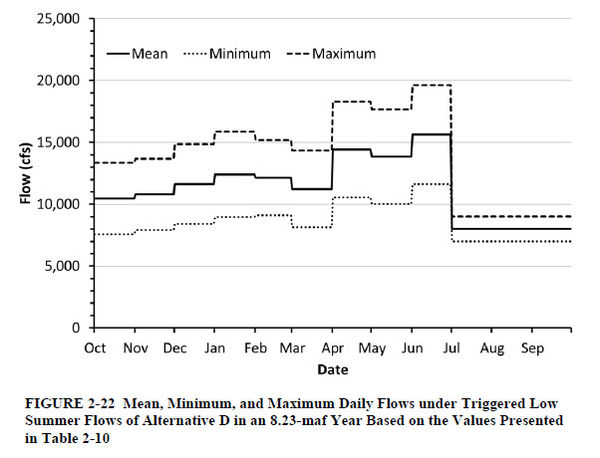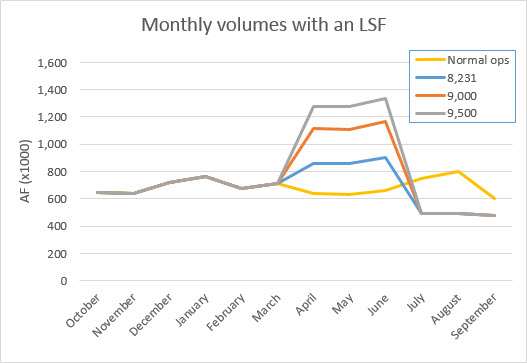Difference between revisions of "Low Summer Flow Experiment"
Cellsworth (Talk | contribs) |
Cellsworth (Talk | contribs) |
||
| (7 intermediate revisions by the same user not shown) | |||
| Line 24: | Line 24: | ||
|style="width:60%; font-size:120%;"| | |style="width:60%; font-size:120%;"| | ||
| − | Low summer flows (minimum daily mean 5,000 to 8,000 cfs) for three months ( | + | Low summer flows (minimum daily mean 5,000 to 8,000 cfs) for three months (July, August, and September) and only in the second 10 years of the LTEMP period (2026-2036) for the purpose of achieving warmer river temperatures of ≥14°C at Little Colorado River confluence to benefit humpback chub and other native species. <br> |
The experiment would '''not''' be conducted if: | The experiment would '''not''' be conducted if: | ||
# Release temperatures were too low to reach 14°C at Little Colorado River confluence even with going to a minimum flow of 5,000 to 8,000 cfs, or | # Release temperatures were too low to reach 14°C at Little Colorado River confluence even with going to a minimum flow of 5,000 to 8,000 cfs, or | ||
| − | # Release | + | # Release temperatures were predicted to be high enough in July, August, or September to reach 14°C at Little Colorado River confluence under normal operations. |
|}<!-- | |}<!-- | ||
| Line 101: | Line 101: | ||
*Increased [http://gcdamp.com/index.php?title=GCDAMP_Sediment sediment transport] during the high releases in the months prior to the LFS test in order to get the annual volume commitment to the Lower Basin. | *Increased [http://gcdamp.com/index.php?title=GCDAMP_Sediment sediment transport] during the high releases in the months prior to the LFS test in order to get the annual volume commitment to the Lower Basin. | ||
*Increased potential for [http://gcdamp.com/index.php?title=Nonnative_Invasive_Aquatic_Species nonnative fish and parasites] to proliferate throughout the Grand Canyon and impact humpback chub and other native fish populations. | *Increased potential for [http://gcdamp.com/index.php?title=Nonnative_Invasive_Aquatic_Species nonnative fish and parasites] to proliferate throughout the Grand Canyon and impact humpback chub and other native fish populations. | ||
| − | *The cost to hydropower users from [http://gcdamp.com/index.php?title=The_2000_Low_Summer_Steady_Flow_Experiment '''the 2000 Low Summer Steady Flow Experiment'''] was estimated to be $26.4 M, which probably made it the single most expensive science experiment in US history. | + | *The cost to hydropower users from [http://gcdamp.com/index.php?title=The_2000_Low_Summer_Steady_Flow_Experiment '''the 2000 Low Summer Steady Flow Experiment'''] was estimated to be $26.4 M, which probably made it the single most expensive environmental science experiment in US history. |
{| class="sortable wikitable" style="text-align:center;" | {| class="sortable wikitable" style="text-align:center;" | ||
| Line 127: | Line 127: | ||
*It may be difficult to schedule mid-year monthly releases in order to meet annual release requirements. Monthly volumes of October-December are typically pre-determined to release 2.0 MAF. Annual release volumes are typically only set after the April 1 inflow forecasts leaving April, May, and June as the only months water could be moved into from July, August, and September for the LSF. | *It may be difficult to schedule mid-year monthly releases in order to meet annual release requirements. Monthly volumes of October-December are typically pre-determined to release 2.0 MAF. Annual release volumes are typically only set after the April 1 inflow forecasts leaving April, May, and June as the only months water could be moved into from July, August, and September for the LSF. | ||
*Short notice for science planning to monitor affects. One of the primary flaws with [http://gcdamp.com/index.php?title=The_2000_Low_Summer_Steady_Flow_Experiment '''the 2000 Low Summer Steady Flow Experiment'''] was that due to the short amount of time available for planning and implementation and the lack of long-term monitoring, scientists were unable to determine whether or not the experiment achieved its objectives. | *Short notice for science planning to monitor affects. One of the primary flaws with [http://gcdamp.com/index.php?title=The_2000_Low_Summer_Steady_Flow_Experiment '''the 2000 Low Summer Steady Flow Experiment'''] was that due to the short amount of time available for planning and implementation and the lack of long-term monitoring, scientists were unable to determine whether or not the experiment achieved its objectives. | ||
| + | |||
| + | |- | ||
| + | ! <h2 style="margin:0; background:#cedff2; font-size:120%; font-weight:bold; border:1px solid #a3bfb1; text-align:left; color:#000; padding:0.2em 0.4em;">Findings of the [http://gcdamp.com/index.php?title=The_2000_Low_Summer_Steady_Flow_Experiment 2000 LSSF]</h2> | ||
| + | |- | ||
| + | |style="color:#000;"| | ||
| + | |||
| + | *Habitat maintenance flow (a 4-day spike at a powerplant capacity of 877 m³/s) and sustained high releases in April and May (averaging 509 m³/s) resulted in [increased] sediment export | ||
| + | *The habitat maintenance flow resulted in some mid-elevation sandbar building | ||
| + | *Backwaters warmed more than other shoreline environments during the day, but most backwaters returned to mainstem water temperatures overnight | ||
| + | *Humpback chub and other native fishes, did not respond in a strongly positive or strongly negative | ||
| + | *The mean total length of YOY native fishes was similar to the mean length from previous years, but the abundance of YOY native fish was greater in 2000 | ||
| + | *The close proximity of the Little Colorado River to Glen Canyon Dam precluded sufficient warming of the mainstem down to the confluence with the Little Colorado River (RM 61) to reach optimal growth and spawning conditions for humpback chub | ||
| + | *Supported tamarisk seedling establishment | ||
| + | *Increased travel time for whitewater rafting, reduced time spent at attraction sites, increased the availability of low-water camps, and initially increased the number of boating accidents at rapids | ||
| + | *Commercial fishing guides in Lees Ferry lost business during the habitat maintenance flows | ||
| + | *Increased costs of approximately $26.4 million to power users | ||
|- | |- | ||
| Line 137: | Line 153: | ||
*The high abundance of salmonids in the mainstem before the experiment and predation by them may have affected the number and size of native fish that were caught. | *The high abundance of salmonids in the mainstem before the experiment and predation by them may have affected the number and size of native fish that were caught. | ||
*Native larval fish survival in the tributaries that is unrelated to mainstem environments and flow manipulations also can affect relative abundance observed in the mainstem. | *Native larval fish survival in the tributaries that is unrelated to mainstem environments and flow manipulations also can affect relative abundance observed in the mainstem. | ||
| + | |||
| + | |- | ||
| + | ! <h2 style="margin:0; background:#cedff2; font-size:120%; font-weight:bold; border:1px solid #a3bfb1; text-align:left; color:#000; padding:0.2em 0.4em;">Findings of the [http://gcdamp.com/index.php?title=Near_Shore_Ecology_(NSE)_Study 2009-2011 Fall Steady Flow Study]</h2> | ||
| + | |- | ||
| + | |style="color:#000;"| | ||
| + | |||
| + | The NSE project found that annual apparent survival of juvenile humpback chub (size at tagging < 100-mm total length, TL) did not differ significantly between the extant fluctuating flows and the experimental steady flow treatments (Finch et al. in-review A). The NSE project also documented that juvenile humpback chub were able to survive and rear in the mainstem Colorado River even at small sizes of 40-100 mm TL (Finch et al. in-review B). A somewhat surprising finding was that growth in juvenile humpback chub declined during these short-term steady flows versus fluctuating flows even though water temperatures were generally similar (Finch et al. in-review B). Reasons for this counter intuitive growth response are not known, but Finch (et al. in-review B) hypothesizes that food availability in the drift (primarily aquatic insects) is higher in fluctuating flows than in steady flows. | ||
|} | |} | ||
Latest revision as of 10:09, 11 December 2019
|
|
Low summer flows (minimum daily mean 5,000 to 8,000 cfs) for three months (July, August, and September) and only in the second 10 years of the LTEMP period (2026-2036) for the purpose of achieving warmer river temperatures of ≥14°C at Little Colorado River confluence to benefit humpback chub and other native species. The experiment would not be conducted if:
|
| --- |
--- |
--- |
|---|
|
|

